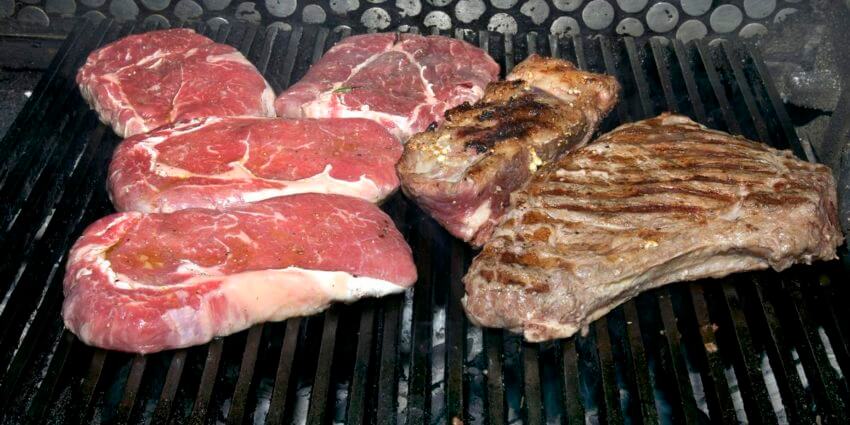It’s The Lack Of Soluble Fiber.
For years you’ve been hearing of “the dangers of red meat”, that it causes everything from heart disease to cancer. That it ferments (or “rots”) in our gut, makes the gut acidic, etc. However, several new studies show that red meat isn’t a problem after all.
Much like the debunked advice to avoid eggs and dietary cholesterol, the “avoid red meat” myth is quickly falling apart.
In my mind any food that our ancient ancestors (prior to 10,000 years ago) routinely ate for eons is most likely going to be beneficial for us. New studies come out every month that validate this idea. We may still have to worry about modern cooking techniques, farming methods, pesticides, antibiotics, quantity consumed, etc. But the basic food should be healthy for us.
Animal protein is no exception. Our ancestors were “hunter gatherers”, they spent a lot of time hunting animals for meat. This included “red meat”. Ancient humans were not very selective in the protein they consumed, they ate what was available; fish, birds, eggs, rats, bison, deer, wild pigs, etc. But a large hoofed animal kill was prized, it allowed them to feed many people, for several days. The organs were particularly prized as they contained concentrated nutrition, far more nutrition (per ounce) than any other food available to them.
The World Health Organization (WHO) has classified processed meats as being a carcinogen, but not other meats.
“Processed meat includes hot dogs, ham, bacon, sausage, and some deli meats. It refers to meat that has been treated in some way to preserve or flavor it. Processes include salting, curing, fermenting, and smoking.”
Processed meats are high in nitrates and other preservatives, which do have links to cancer. Char cooking meats creates carcinogens (such as heterocyclic amines and polycyclic aromatic hydrocarbons). The more char, the more carcinogens are created. Non-organic meat can contain traces of pesticides, antibiotics and bovine hormones. The omega 6 to omega 3 fat ratio of animals fed grain is much higher than pasture raised animals (grass-fed animals have up to 6 times the amount of omega 3). So our meat today is not always the same as our ancestors. However, even the processed meat correlation to cancer is a weak one (I’ll still eat an occasional hotdog or salami on rye).
Confined / Concentrated Animal Feeding Operations (CAFO) deprive cattle of green grass that they use to make Vitamin K2 (very important to our health, and hard to get else where). These lots also deprive the cows of sunshine, the cows are subject to intolerable stress, they require the use of antibiotics to keep them from dying of disease, etc. Not to mention that this is very inhumane treatment. These cows are sickly compared to pasture raised cattle and consuming the meat from these animals is not going to be as healthy. When ever we can we should consume organic grass-fed / grass finished red meat products.
Evidence shows a much stronger cancer correlation with high-glycemic index foods, such as sugar, bread, wheat, pasta and potatoes, than it does with standard store bought red meat products. People eating more of these types of foods had a 49% increase in lung cancer and a whopping 92% increase in squamous cell carcinoma! To think, some people may see a reduction of 50% or more in certain cancer risks simply by eliminating or reducing these foods.
Rapidly absorbed carbohydrates are associated with postmenopausal breast cancer risk among overweight women and women with large waist circumference. Carbohydrate intake may also be associated with estrogen receptor-negative breast cancer.” – PubMed ID#18469262 (2008)
Most studies that you’ll find on the health effects of red meat fail to control for vegetable and fiber intake (as well as sugar and other junk food consumption). In other words, people that eat a lot of red meat nearly always consume fewer vegetables and less soluble fiber, (and often more sugar), they just don’t have the room in their stomach for both. Thus these studies really tell us very little. But other studies confirm that it is the lack of beneficial vegetables and the quality of the meat causing the health issues found in the red meat studies. Consuming fewer vegetables deprives us of micro nutrients that our body needs to protect us from cancer, heart disease, etc. It also deprives our microbiome (our good gut bacteria), more on this below. The benefits of high soluble fiber diets are well known.
“Solubilized wheat AX (arabinoxylan) has the potential to counteract the effects of dietary red meat by reducing protein fermentation and its resultant toxic end products such as ammonia, as well as leading to a positive shift in fermentation end products and microbial profiles in the large intestine.” – PubMed ID#26740253 (2016)
Other soluble fibers will do the same job, feed our beneficial bacteria so they aren’t forced to consume red meat. Keep in mind that throughout our history humans often had to resort to consuming solely animal protein. An early or late winter could lead tribes without supplies of stored plant matter and they would resort to consuming most any animal, as well as to eating more fish if available. Meat is our microbiome’s backup system. It keeps it alive when times are tough; but in doing so it produce a small amount of toxin (that our liver and kidneys can usually easily handle). What we’re talking about here are the negative results from long term consumption of only animal protein (no soluble fiber), there are no short term consequences. A standard “hunter gatherer” diet (where you would eat both meat and vegetables) will not produce these toxins.
Even the risk of colorectal cancer was not higher with a high beef diet. This study did not control for the amount of vegetables consumed, and the results would undoubtedly have shown even less of a correlation had it controlled for vegetable consumption (e.g. meat eaters consuming more vegetables would have shown an even lower cancer risk).
“Overall red meat consumption was associated weakly with CRC risk, significant only for lamb and pork, but not for beef, irrespective of tumor location. Processed meat was associated with mild CRC risk.” — PubMed ID#30640205 (2019)
Animal protein in the human diet is so important that we would literally die without it. This is not hyperbole, it is fact. To start with the only foods that naturally contain vitamin B12 come from animals; you can not get any B12 from vegetables, fruit, or grains (unless it is processed and B12 has been added). Humans can store a good deal of vitamin B12 for later use. However, in fewer than 10 years from going vegan, a person will have to supplement B12, eat meat, or suffer some awful neurological consequences (and soon after, death). In all of recorded human history (and archaeological evidence) there has never been a civilization that lived on a vegan diet. There is a reason for that.
(note: if you consume a vegan diet for philosophical or moral reasons more power to you. Just be sure you do it right by getting your proper amino acids, fatty acids, supplement vitamins B12 and K2. A vegan diet can be very difficult to do correctly and you will probably still be missing out on some important micro nutrients)
You’ll also often hear that plant protein is better for us than animal protein, this too is not true.
“when we actually track down the direct correlation between animal protein and cancer, there is no statistically significant positive trend. None. Looking directly at animal protein intake, we have the following correlations with cancers… when we look solely at the variable “death from all cancers,” the association with plant protein is +12. With animal protein, it’s only +3.” — Denise Minger’s excellent statistical analysis of meat consumption studies. A must read.
Certain vegan websites will often point to studies linking red meat to a compound called trimethylamine-N-oxide (TMAO). TMAO is created from the breakdown of carnitine in the gut. TMAO has been associated with atherosclerosis, a disease in which plaque builds up inside the arteries, and raises the risks for heart disease and cardiac events such as heart attack and stroke. Here are a few things these sites don’t tell you:
- your risk is very dependent on the health of your microbiome.
- several studies have shown no increase risk in heart disease and stroke from the consumption of unprocessed red meat
- carnitine is found in red meat, but it is also found in very high amounts in eggs, fish, shellfish, chicken (both white and dark meat), and dairy (including human breast milk). It is also found in wheat, asparagus and several other vegetables.
- carnitine is a conditionally essential nutrient for infants and some adults with a specific genetic disorder
- even if you consume no carnitine your body will synthesize it from the amino acids methionine and lysine.
- new research shows that TMAO may not cause these conditions, but is more of a marker of a weakened microbiome. It is the weak microbiome responsible for the disease. Thus what we have is a “hungry bacteria syndrome” (a term I just made up)
TMAO levels have also been linked to the makeup of gut bacteria. Therefore this may very well be linked to hungry bacteria syndrome mentioned above; when gut bacteria aren’t fed properly (e.g. soluble fiber) they start consuming carnitine. High TMAO levels may also be linked to unhealthy levels of certain unwanted gut bacteria, such as certain e.Coli strains.
“Trimethylamine N-oxide (TMAO) is produced when trimethylamine, a waste product of gut microbes, is converted via hepatic flavin monooxygenases. As TMAO is a potential causative factor in various cardiovascular diseases (CVDs) considerable research interest has arisen on its use as a biomarker… An increasing body of evidence suggests that the human intestinal gut microbiota—composed of tens of trillions of bacteria— and microbiota-derived metabolites play roles in various diseases, including cardiovascular disease (CVD) and stroke… A population-based study of adults between 33 and 55 years reported that plasma TMAO was not associated with the 10-year incidence or progression of coronary artery calcium or intima-media thickness. Thus, these data suggest that TMAO may not be the “culprit” but may be considered as a potential biomarker. High levels of circulating TMAO may reflect changes in the composition of the gut microbiota which increase disease susceptibility.” — PubMed ID#PMC6549071 (2019)
Again, the TMAO arguement is often used to scare you away from eating red meat. But it is obvious that we can not avoid carnitine (its precursor). So the trick is not to avoid meat, but to consume it properly and keep the gut’s microbiome healthy and well fed.
Here are some tips for healthier meat consumption:
- avoid charring the meat as much as you can. At least limit how often you consume charred meat
- try to purchase organic grass-fed meat when possible and within your budget (cutting out junk food may allow you to purchase better quality meat)
- take a soluble fiber supplement daily, such as larch tree arabinogalactan
- consume more vegetables high in soluble fiber. This might require that you consume less meat.
- keep your gut in good order and maintain a balanced microbiome
The Gut Health Protocol is a good start to learning how to maintain a healthy gut.
All images and text © The Gut Health Protocol or used under license. All rights reserved.
All images posted by John Herron are either "Copyrighted John Herron", or are copyrighted by someone else and are used under license. So please don’t use them elsewhere, you’ll get in trouble.


 Phage Complete comes with a full 30 day money back guarantee, for U.S. purchases this includes the original shipping charges to you!
Phage Complete comes with a full 30 day money back guarantee, for U.S. purchases this includes the original shipping charges to you!
John, looking forward to your research. The world needs you!